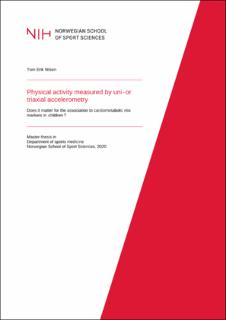| dc.description.abstract | Background: Differences in physical activity measured by uni- and triaxial accelerometry and their magnitude of association to metabolic health and the influence of epoch length in children is unknown.
Methods: We used data from a 7-month school-based randomized controlled trial conducted over the school year 2014-2015 in Sogn & Fjordane county in Norway. Data were available for a total of 1129 children of which 659 had complete physical activity, prospective cardiometabolic and covariate data. We applied the Romanzini cut points to the accelerometer data. These cut points provide thresholds for both uni- and triaxial estimates that are calibrated from the same data. Time spent sedentary, light, moderate, vigorous, and moderate-to-vigorous was then analyzed in 1, 10 and 60-s epoch length. We analyzed the prospective association between a cardiometabolic risk score and sedentary time, light, moderate, vigorous, moderate-to-vigorous physical activity by linear regression models. We used mixed regression models to describe the dose-response patterns of moderate-to-vigorous physical activity to cardiometabolic risk. We computed a composite cardiometabolic risk score by summing the z-scores of waist-to-height ratio, systolic blood pressure, triglycerides, total cholesterol: high density lipoprotein ratio, insulin and cardiorespiratory fitness.
Results: All physical activity estimates where significantly different between the uni- and triaxial data reduction. At most, this led to a relative difference of 42.5% higher physical activity guideline compliance. The uni- and triaxial estimates of sedentary time and physical activity associations to metabolic health does not follow any general pattern. The dose- response patterns of moderate-to-vigorous physical activity were similar, but the magnitude of association were greater between the least and most active quartile when measured uniaxial.
Conclusion: Triaxial physical activity estimates show lower prospective associations to cardiometabolic health, especially for moderate, vigorous and moderate-to-vigorous physical activity. The uni- and triaxial difference in the prospective associations is attenuated in longer epoch lengths. The dose-response patterns of MVPA are similar between the number of axes used and epoch length, but the magnitude of association between the least and most active quartile are greater when measured uniaxial. | en_US |
